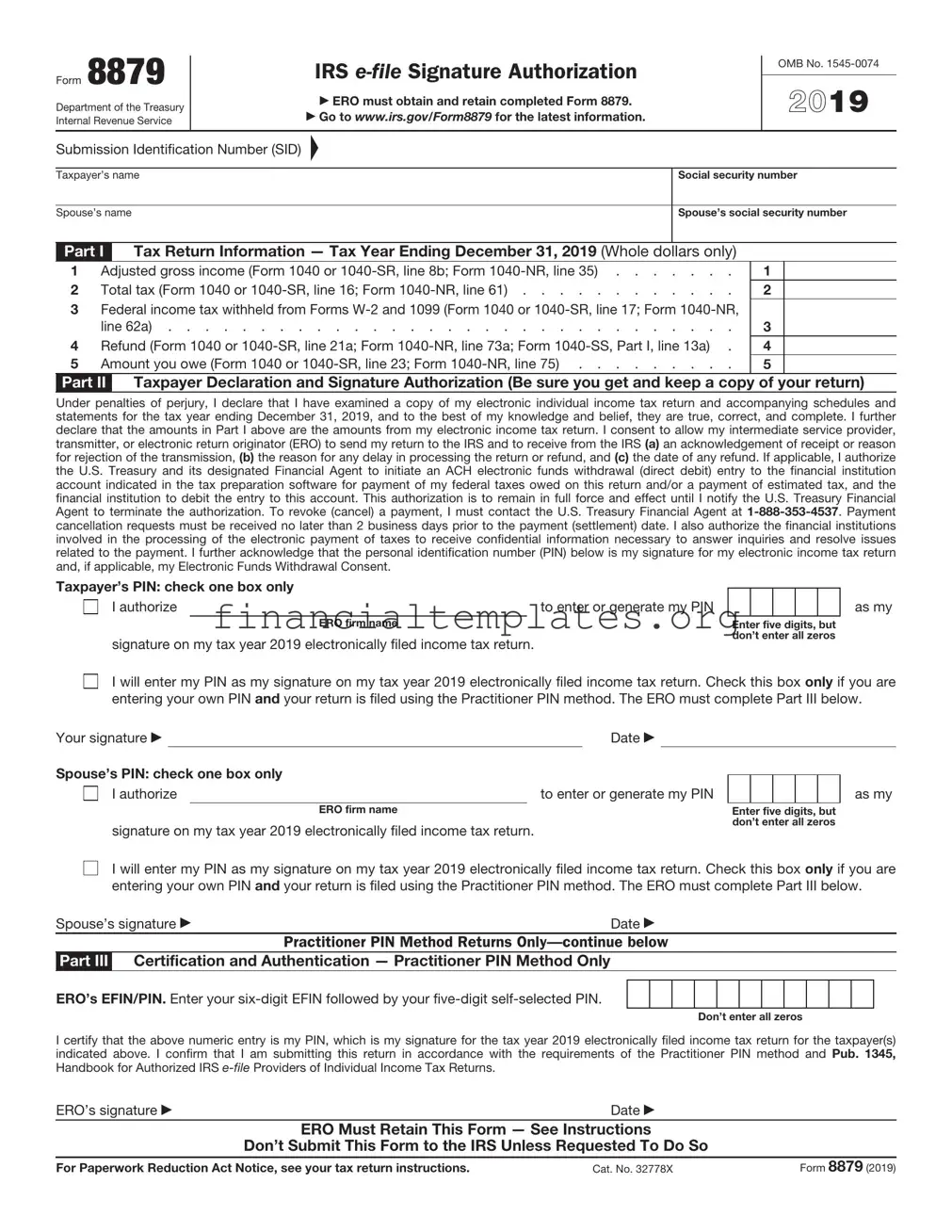The IRS 8879 form serves as an electronic signature authorization form that taxpayers use to e-file their tax returns. A document that shares similarities with the IRS 8879 form is the Form 1040, the U.S. Individual Income Tax Return. Both documents are integral to the tax filing process, requiring accurate taxpayer information and being directly linked to the Internal Revenue Service (IRS). While the 1040 form is used to calculate and report an individual's annual income tax, the 8879 form authorizes the electronic submission of the 1040, among other forms.
Another related document is the W-2 form, which employers use to report their employees' annual wages and the amount of taxes withheld from their paychecks. Like the IRS 8879, the W-2 is fundamental in the filing of taxes, providing essential information needed to complete the Form 1040. The critical similarity lies in their role in ensuring taxpayers' compliance with the IRS requirements for accurate and timely tax reporting.
The 1099-MISC form, used to report miscellaneous income, also shares similarities with the IRS 8879. Both are crucial for accurate tax reporting and compliance with IRS regulations. While the 1099-MISC documents income from sources other than a traditional employer, the 8879 ensures that these details, among other reported incomes, are electronically submitted to the IRS correctly.
Form 4868, the Application for Automatic Extension of Time To File U.S. Individual Income Tax Return, is another document comparable to the IRS 8879. Both these forms assist taxpayers in managing their filing obligations – the 4868 by providing additional time to file and the 8879 by facilitating the electronic filing process. They are designed to aid in adherence to IRS deadlines and requirements.
The IRS Form 8822, Change of Address, though seemingly distinct, is closely tied to the procedural aspects of filing taxes, much like the 8879 form. It ensures the IRS has current taxpayer information, crucial for the proper processing and filing of forms like the IRS 8879 and others within the tax reporting framework.
Akin to the IRS 8879 is the Form 7004, Application for Automatic Extension of Time to File Certain Business Income Tax, Information, and Other Returns. Though one serves individual taxpayers and the other businesses, both are aimed at streamlining compliance with tax deadlines through extensions (Form 7004) or electronic filing facilitation (Form 8879).
Form 8962, the Premium Tax Credit, shares a connection with IRS 8879 in its use within the tax filing system, particularly for individuals obtaining health insurance through the marketplace. This form's role in calculating the premium tax credit complements the 8879’s function in electronically filing tax returns that claim such credits.
The Schedule C, Profit or Loss from Business, is a form used by sole proprietors to report their business earnings and expenses. Its relationship with the IRS 8879 form lies in the necessity of both for self-employed individuals engaging in electronic filing. The accurate reporting on Schedule C is essential for the 8879 to authorize the tax return’s submission correctly.
Form 8889, Health Savings Accounts (HSAs), parallels the IRS 8879 in the sense that both deal with specific tax-related circumstances – the 8889 with HSA contributions and distributions, and the 8879 with electronic filing authorization. Each plays a pivotal role in managing particular aspects of taxpayers' obligations and benefits.
Lastly, the W-9 form, Request for Taxpayer Identification Number and Certification, correlates with the IRS 8879 through their collective requirement in the tax filing process. While the W-9 is often used to ensure that the correct taxpayer information is on file for various transactions, the 8879 leverages this information to authenticate and electronically submit tax documents to the IRS.

